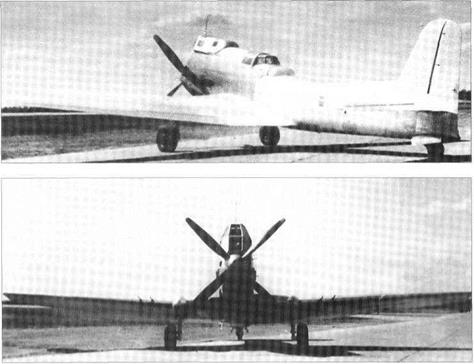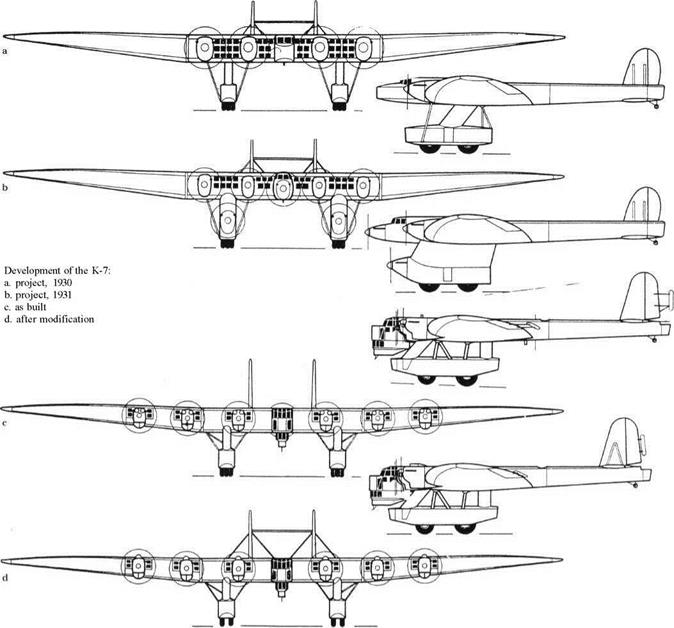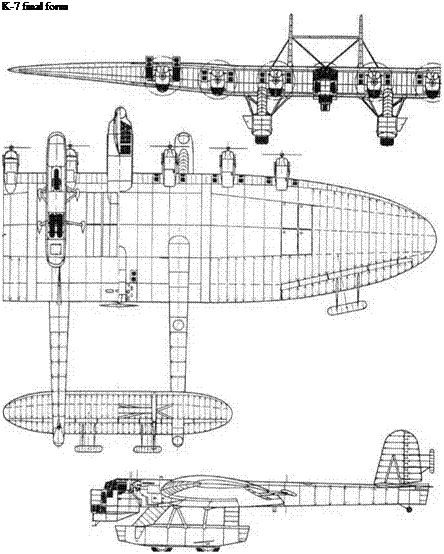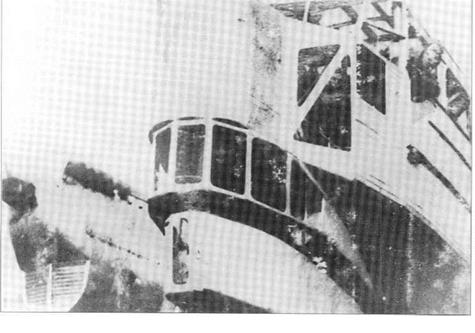Kalinin K-7

Purpose: To create a super-heavy bomber. Design Bureau: OKB ofK A Kalinin,
Kharkov.
From 1925 Kalinin made himselffamous with a series of single-engined aircraft characterised by having a quasi-elliptical monoplane wing. In 1930 he sketched a gigantic transport aircraft, the K-7, with a tail carried on two booms and with four 1,000hp engines mounted on the wing, which was deep enough to house 60 passengers or 20 tonnes of cargo. No engine of this power was readily available, so in 1931 he redesigned the aircraft to have seven engines of (he hoped) 830hp. GUAP (the Ministry of Aviation Industry) gave permission for the aircraft to be built, but with the role changed to a heavy bomber. This meant a further total redesign, one
change being to move the centreline engine to the trailing edge. This near-incredible machine was completed in summer 1933. Ground running of the engines began on 29th June, and it was soon obvious from serious visible oscillation of the tail that the booms were resonating with particular engine speeds. The only evident solution was to reinforce the booms by adding steel angle girders, and brace the tail with struts. Flight testing by a crew led by pilot M A Snegiryov began on llth August 1933, causing intense public interest over Kharkov. On Flight 9, on 21st November, during speed runs at low altitude, resonance suddenly struck and the right tail boom fractured. The aircraft dived into the ground and burned, killing the pilot, 13 crew and a passenger; five crew survived. Kalinin was sent to a new factory at Voronezh. Here
a plan was organised by P I Baranov to build two improved K-7s with stressed-skin booms of rectangular section, but this scheme was abandoned in 1935, the K-7 no longer being thought a modern design.
The basis of this huge bomber was the enormous wing, of typical Kalinin plan form. It had CAHI (TsAGI) R-II profile, with a thick – ness/chord ratio of 19 per cent, rising to 22 per cent on the centreline, where root chord was 10.6m (34ft 9%in) and depth no less than 2.33m (7 ft 7%in). The two main and two subsidiary spars were welded from KhMA Chro – mansil high-tensile steel, similar lattice girder construction being used for the ribs. The wing was constructed as a rectangular centre section, with Dl skin, and elliptical outer sections covered mainly in fabric. A small nacelle of Dl stressed-skin construction projected from

|
|


the leading edge. On the leading edge were six 750hp M-34F water-cooled V-12 engines, each with a radiator underneath, and driving a two-blade fixed-pitch propeller; a seventh engine was on the trailing edge. Walkways along the wing led to each engine, and on the ground mechanics could open sections of leading edge to work on the engines without needing ladders. Metal tanks in the wings housed 9,130 litres (2,008 Imperial gallons, 2,412 US gallons) offuel. Just outboard of the innermost engines were the booms holding the tail, 11 .Om (36ft P/in) apart, each having a triangular cross-section with a flat top. The elliptical horizontal tail carried twin fins and rudders 7.0m (22ft 11 Jfin) apart. All flight controls were driven by large servo surfaces carried downstream on twin arms. Under the wing, in line with the booms, were extraordinary landing gears. Each comprised an inclined front strut housing a staircase and a vertical rear strut with an internal ladder. At the bottom these struts were joined to a huge gondola. Each gondola contained three large wheels, one in front and two behind, holding the aircraft horizontal on the ground. In front of and behind the front wheels were bomb bays with twin doors. Maximum bomb load was no less than 19 tonnes (41,8871b). Defensive armament comprised a 20mm cannon in a cockpit in the nose, two more in the ends of the tail booms and twin DA machine guns aimed by gunners in the front and rear of each gondola. Total crew numbered 11, all linked by an intercom system.
Though a fantastic and deeply impressive aircraft, the K-7 was flawed by its designer’s inability to solve the lethal problem of harmonic vibration. Even without this, it would probably have been a vulnerable aircraft in any war in which it might have taken part.
|
|||||||||||||||||||||||||||||||||
|
|||||||||||||||||||||||||||||||||
|












